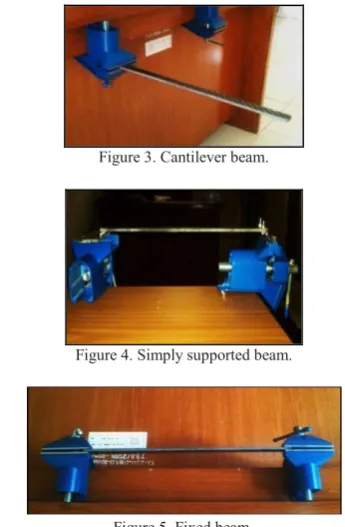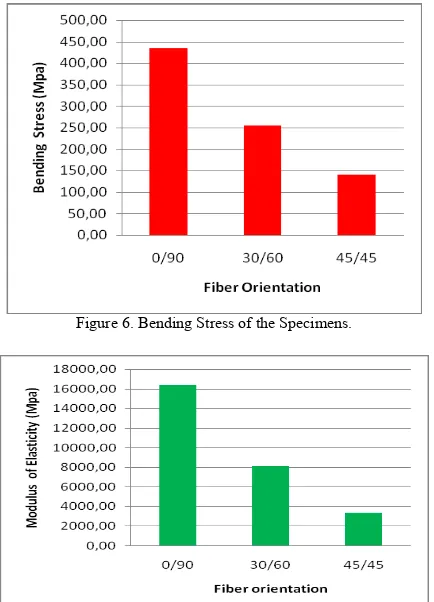The Effect of Fiber Orientation on the Dynamic
Characteristic of the Carbon
–
Glass Fiber
Hybrid Composite
Didik Djoko Susilo*,
Nur Hafid
*, Wijang Wisnu Raharjo
** Department of Mechanical Engineering
University of Sebelas Maret, Surakarta, Jawa Tengah, Indonesia Jl. Ir. Sutami No. 36A Surakarta, Indonesia
Abstract
—
This resarch is to study the effect of the fiber orientation on the dynamic characteristic of the carbon-glass fiber hybrid composite. The dynamic charactristics studied was damping ratio and natural frequency. The hybrid composite was made by hand lay up medtod using volume fraction of 0.4 and dimension of 250 x 40 x 3 mm. Fiber orientations used in this experiment were 0o/90o, 30o/60o, and 45o/45o. The vibration experiment was done by giving excitation to the composite specimen using impact hammer and the vibration response was obtained from the accelerometer attached on the specimens. Three type of the supported beam configurations used in this experiment, i.e: cantilever beam, simple supported beam, and fixed supported beam. The experiment results showed that the fiber orientation affects to the dynamic characteristics of the carbon-glass fiber hybrid composite. This is due to the flexular rigidity of the composites. Fiber orientation of 0o/90o have the highest flexular rigidity, so it have high natural frequencies at all beam configuration in compare to the other fiber orientation. Its natural frequencies at at the configuration cantilever beam, simple supported beam, and fixed beam are 39 Hz, 105 Hz, and 261 Hz respectively. Damping ratio behave in opposite way to the natural frequency, carbon-glass fiber hybrid composite which low rigidity i.e. fiber orientation of 45/45 gives high damping ratio in all beam configuration, and the highest is 0.0038 found in cantilever beam configuration.Kata kunci : hybrid composite, fiber orientation, support configuration, damping ratio, frequency natural.
I. INTRODUCTION
The usage of composites material in engineering application have been growing rapidly. Many kind of industries use them like automotive, aircraft, marine, household, etc. This wide use of compsites are because of their strength-weight ratio, adaptability to different situations, and the relative ease combination with other materials to serve spesific purposes and exhibit desirable properties.
A composite is a structural material that cconsists of two or more constituents that are combined at macroscopic level and are not soluble each other. One constituent is called reinforcing phase and thi other is the matrix. The reinforcing
phase can be found in the form of fibers, particles, or fluke, while the matrix phase materials are generally continuous.
Hybrid composites are composites consisting of two constituents at the nanometer or molecular level. The purpose of the hybridization is to take benefits in cost and enhancement of mechanical properties.
An example of hybrid composite is carbon-glass fiber hybrid composite. This material has been the object of researches to obtain its mechanical and dynamic characteristics. Yeramalli and Wass, [ 1 ], studied the response of glass – carbon fiber hybrid composite under compressive load. They found that using total fiber volume fraction of 30 %, the failure strength decreased as the hybrid ratio increased, with the minimum decrease coinciding with a ratio of 50 % glass and 50 % carbon. Anwar et.al [ 2 ], Prabhakaran et.al [ 3 ] stated that tensile and compressive strength of this hybrid composite is still below the strentgh of carbon epoxy composite and glass epoxy composite. Eventhough, if the proportion of carbon fiber increase, the tensile strength will increase. GuruRaja and HariRao, [ 4 ] studied the effect of angle ply orientation to the tensile properties of carbon-glass hybrid composite. They found that angle ply orientation of 0o/90o showed significant increase in tensile properties as compare to the angle of 45o/45o and 30o/60o.
Beside of mechanical properties, dynamic properties of a material also play important rule in the usage of a material. It is needed to predict the behaviour of a material when subjected to dinamic loading. Dynamic characteristics of a material are represented by its natural frequencies, damping ratio and mode shape. Some researchs on dynamic of composites could be mentioned as follows: Mishra and Sahu, [ 5 ], studied the vibration response of fiber glass composite plate. They found that vibration response of glass fiber composite plate was affected by the number of laminate layers, fiber orientation, and the ratio of cross-sectional size. The more the number of layers of the laminate would increase the natural frequency of the composite. Likewise, the increasing of the ratio of cross-sectional size would increase the natural frequency of composite structures. While the increase in fiber orientation angle ply would reduce the natural frequency of
Page 383 of 436
the composite. Mohammed. [ 6 ] investigated the effect of number of the carbon layer, its position and orientation angle of laminate to the natural frequencyies and mode shapes of hybrid fiber (carbon/glass) with epoxy laminate. The result showed that the natural frequencies increased when the number of carbon layer increases, and decreased when carbon layer position change from the surface toward mid plane, also the natural frequencies change with changing fiber orientation. This study will investigate the effect of fiber orientation and support configurations to the dynamic charanteristics of carbon-glass fiber hybrid composite. The dynamic characteristics studied are natural frequencies and damping ratio. Hybrid laminate composite was made by stacking sheets of carbon and glass fibres in a required orientation to form angle ply of laminate. Dinamics characteristics was obtained from experimental modal analysis according to ASTM E 756-98
II. EXPERIMENTALPROCEDURE
A. Specimen Preparation
The hybrid composites were made of carbon fiber and glass fiber , unsaturated polyester resin Yucalac BQTN 157 - FR , and MEKPO catalyst ( methyl ethyl ketone perokside ). The fiber volume fraction (Vf) used in the experiments was 0.4 and the comparison between the composition of carbon and glass fiber is 50:50. The carbon fiber and glass fibers are arranged in the mold to form angle orientation of the fiber. The schematic of the fiber orientation is given in the pictures below: fabricated as per the ASTM standard shown below:
Figure 2. Specimens for modal testing.
B. Experiment Modal Testing
Modal testing was done using impact hammer to excite the specimens. Impact hammer used was Dytran 5800 SL with sensitivity of 100 mV/lb. The vibration response was measured using Dytran accelerometer 3032 A with sensitivity of 10 mV/g. Three types of beam configurations were used in the experiment, i.e: cantilever beam, simple supported beam, and fixed beam as shown in the figures 3-5 below:
Figure 3. Cantilever beam.
Figure 4. Simply supported beam.
Figure 5. Fixed beam.
Then, signal from impact hammer and accelerometer was proceed to obtain frequency response function (FRF) through fast fourier transform (FFT). From the FRF, the natural frequency of each specimen was determined, and the damping ratio was counted using half power bandwith method.
III. RESULTSANDDISCUSSIONS
The experimental result of the carbon – glass fiber hybrid composites is presented in the Table 1 below:
Table 1. Experimental result.
From the table 1 above, it can be seen that fiber orientation of carbon-glass hybrid composite give significant effect to the natural frequency and the damping ratio of the composite in
Page 384 of 436
all configuration of the beams. Fiber orientation of 0/90 yields the highest natural frequency and the lowest damping ratio at all beam configuration, for example in the fixed beam configuration its natural frequency is 261 Hz, and damping ratio of 0.009, almost no damping. Meanwhile fiber orientation of 45/45 yields the lowest natural frequency and the highest of damping ratio at all beam configuration. For example, in the cantilever beam configuration, fiber orientation of 45/45 yields natural frequency of 19 Hz and damping raio of 0.038.
It is also can be seen in the table 1 that beam configurations also affect to the natural frequencies and damping ratios of the hybrid composites. The more rigid configuration of the beam will raise the natural frequency of the composite and decrease the damping ratio.
These are happened due to rigidity of the hybrid composites and their structures. The excitation forces were given in the transversal direction, so the flexural rigidity of material and structures play important rule in determination of dynamic characteristics of the hybrid composite.
In the carbon-glass hybrid composite, the fibres role is to be the stiffener of the composites, so their angle orientation will determine their capacity to resist load in bending mode. At fiber orientation of 0/90, the fiber will be subjected to load at right anggle, so its capacity will be maximum. It is proved by bending test of the specimens that shown ini the figure 6 and 7 below.
Figure 6. Bending Stress of the Specimens.
Figure 7. Modulus of Elasticity of the Specimens
It can be seen from figure 6 that fiber orientation of 0/90 have the highest bending stress in compare with others fiber orientation. Its bending stress reaches 435 MPa. Beside that, this fiber orientation also has the highest modulus of elasticity, like seen in figure 7. These properties make fiber orientation of 0/90 is the most rigid hybrid compsite among the oter fiber orientation. This condition leads the hybrid composites with 0/90 fiber orientation have higher natural frequency or its resonant frequency. Consequently, material with high rigidity will have low capacity to dissipate the energy, so its damping ratio will be low.
On the other hand, configuration of fixed beam will constrain the support of the structure to move in all direction, so the rigidity of the structure become high that will lead to high resonant frequency of the structure like seen in table 1. Fixed beam configuration yields the highest natural frequency in all fiber orientation. Different condition is found in the
Dynamic characteristics of carbon-glass hybrid composite are affected by fiber orientation of hybrid composites and the type of structural application. Fiber orientation of 0/90 gives high natural frequency at all supported beam configuration in compare to the other fiber orientation. The highest natural natural frequency. Carbon-glass fiber hybrid composite which fiber orientation of 45/45 give high damping ratio in all beam configuration, and the highest is 0.0038 found in cantilever beam configuration.
ACKNOWLEDGMENT
Authors would like to acknowledge to the Mobil Listrik Nasional (Molina) Project, Sebelas Maret University Surakarta for supporting this reasearch.
REFERENCES
[1] C.S. Yeramalli, A. Wass, “Compressive Behaviour of Hybrid Composite,” 44th AIAA/ASME/ASCE/AHS Structure, Structural Dynamic and Materil Conference, American Institut of Aeronoutics and Astronoutic, Virginia, April 7-8, 2003.
[2] M. Anwar, W. W. Raharjo, Suyitno, “ Study of Carbon Fiber Reinforced Polymer Characteristic for Electric Vehicle”, International Conference
and Exibition on Automtive Science and Technology, , Bali, December , 3-4, 2012, pp. 30-33
[3] R. T. D., Prabhakaran, T. L. Andersen, C. M. Markuses, B. Madsen, H. Lilholt, “ Tensile and Compression Proprties of Hybrid Composites- A Comparative Sudy” The 19th International Conference on Composites Material, Montreal, Juli, 25 – August 2, 2013, pp. 1029-1035.
Page 385 of 436
[4] M. N. GuruRaja, A. N. HariRao, “ Hybrid effect on Tensile Properties of Carbon/Glass Angle Ply Composites”, Journal of Advances in Material, Vol. 2, No. 3, 2013, pp. 36-41.
[5] I. Mishra, S. K. Sahu, “ An Experimental Approach to free Vibration Response of Woven Fiber Composites Plates under Free-Free Boundry Condition”, International Journal of Advance Technology and Civil Engineering, Vol. 1, Issue-1, 2012, pp. 67-72.
[6] O. A. Mohammed, “ Vibration Analysis of Hybrid Laminated Composites Beam”, Al Rafidain Engineering, Vol 21, No 4, August, 2013, pp 1-13.

